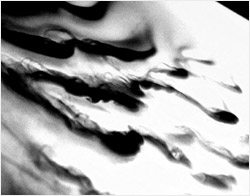 |
Projects
Mixing induced by wave-breaking in a
dense current flowing down a sloping bottom in a rotating fluid
Claudia Cenedese and J.A. Whitehead
A density driven current was generated in the laboratory by
releasing dense fluid over a sloping bottom in a rotating freshwater
system. The behavior of the dense fluid descending the slope
has been investigated by systematically varying four parameters:
the rotation rate, the bottom slope, the flow rate of the dense
fluid, and the density of the dense fluid.
Over a wide range of parameter values, the following three flow
types were found: laminar, wave and eddy regime. All of the
experiments revealed that increasing the slope angle and the
density of the dense fluid allowed the flow to evolve from the
laminar to the wave regime (figure 1). Furthermore, increasing
rotation rate induced the formation of eddies. For values of
the Froude number greater than one the wave regime was observed
in which wave-like disturbances appeared on the interface between
the dense and fresh fluids. For values of the Froude number
less than one, the laminar regime occurred in which the dense
current had a constant thickness behind the head.
The amount of mixing between the dense and the ambient fluids
was measured and its dependence on the slope angle and on the
value of the Coriolis parameter, f, was determined. Increasing
the slope angle increased the amount of mixing. Similarly, mixing
increased while increasing the Coriolis parameter until it reached
a maximum value for f = 1 s-1. However, for values f > 1 s-1
mixing decreased again. For both series of experiments, mixing
increased significantly when passing from the laminar to the
wave regime; i.e. with increasing Froude number.
 |

Click
to enlarge |
| Figure
2. Picture showing the three-dimensional waves.
The "backward breaking" of the wave crests is also visible
as indicated by the lighter gray regions. |
We believe that mixing between the dense salty water and the
lighter fresh water was caused by breaking waves. In particular,
for some parameter values the waves grew to such large amplitudes
that they were observed to break in a three-dimensional fashion,
possibly increasing the amount of mixing (figure 2). We quantified
the amount of mixing observed and estimated the value of the
entrainment velocity at the interface between the dense fluid
and the fresh overlying fluid.
The results have been compared with previous laboratory experiments
which presented the classic turbulent entrainment behavior and
observational estimates of the Mediterranean and Denmark Strait
overflow. The agreement between the observations and the laboratory
experiments was encouraging and indicated that the waves observed
in the present experiments may be a possible candidate for the
mixing observed during oceanic overflows. |
|

